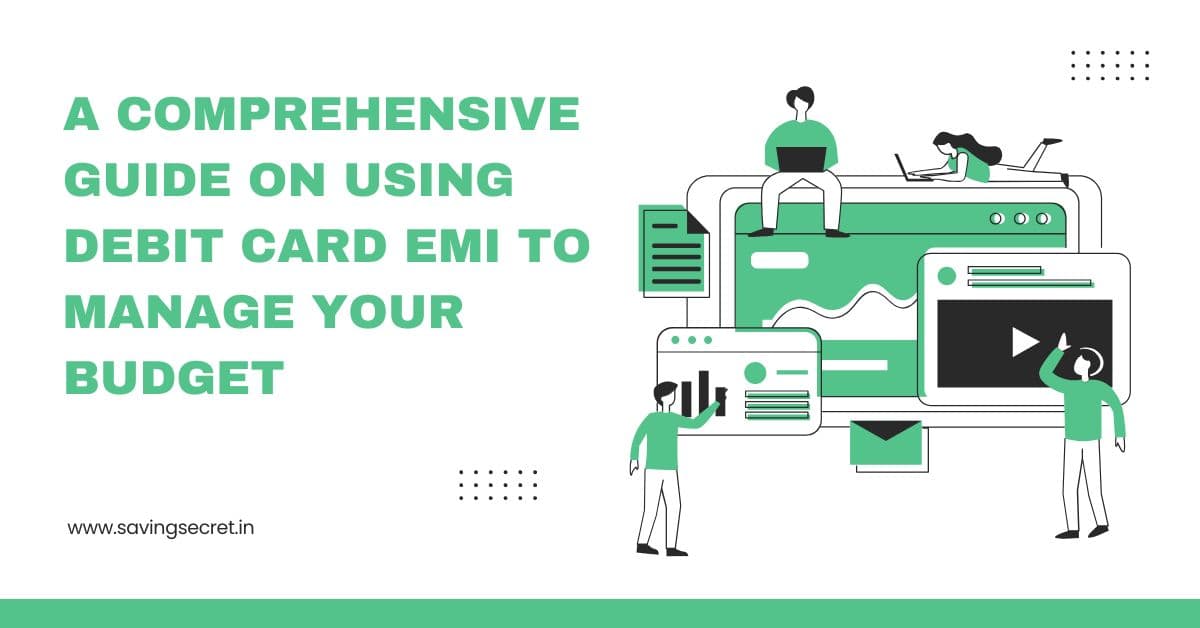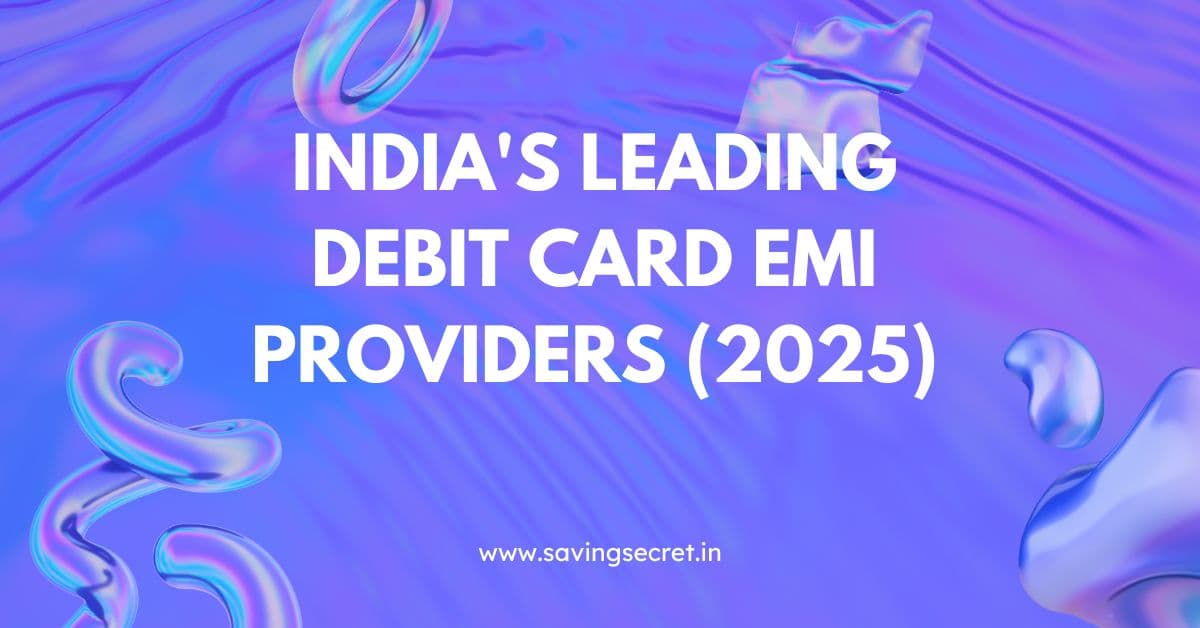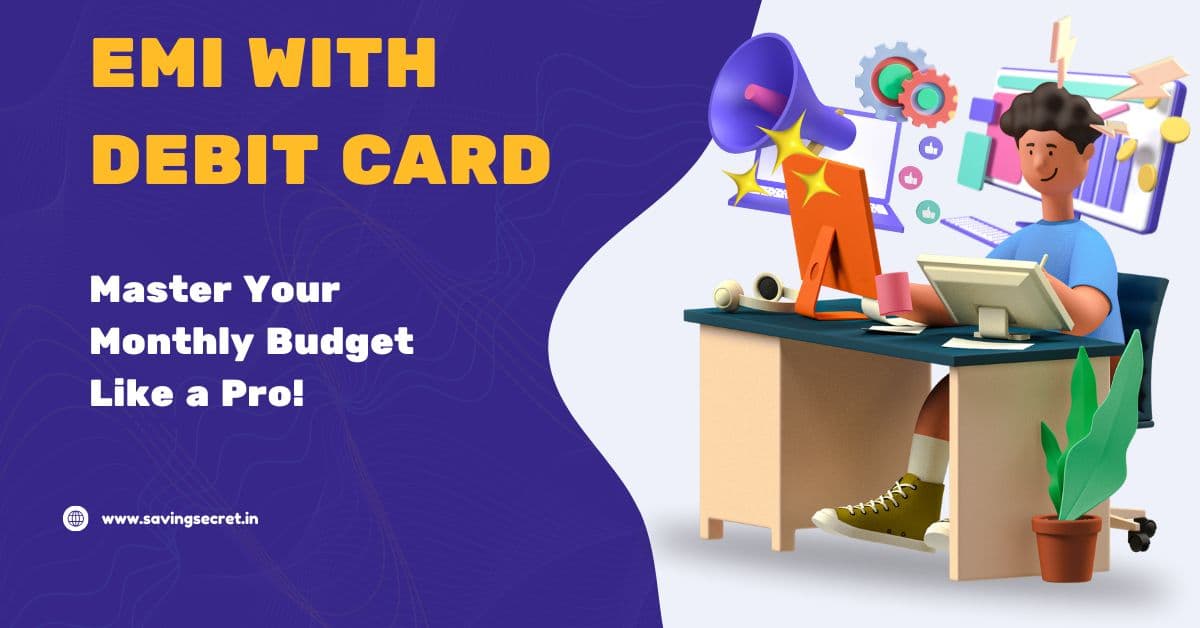Emi with Debit Card? In India, it might be difficult to balance monthly spending with major expenditures like computers, cell phones, or household appliances. Debit cards and EMI (Equated Monthly Instalment) are revolutionary because they allow you to stretch expenses over several months without using loans or credit cards. Debit card EMI is becoming more popular in India due to the country’s surge in digital payments and growing financial knowledge, particularly among students, young professionals, and middle-class families who wish to strike a balance between affordability and financial responsibility.
This guide, written specifically for Indian readers, shows you how to utilise debit card EMI to become an expert at managing your monthly budget in 2025. We cover all you need to know to make wise purchases while managing your finances, from eligibility requirements to the best banks and merchants. This post provides helpful advice, India-specific insights, and resources to make sure your EMI experience is smooth and economical, regardless of whether you’re in Mumbai, Delhi, or a Tier-2 city.
What is the Debit Card EMI?
Without requiring a credit card or an additional loan, debit card EMI enables you to buy goods or services by making fixed monthly payments with your debit card. Debit card EMIs are available to those who don’t have credit or who don’t qualify for credit cards since, in contrast to typical loans, they use your current bank balance or an overdraft facility.

Important Debit Card EMI Features
- Tenure: based on the bank and merchant, 3 to 24 months.
- Interest rates vary per bank and offer and range from 0% (no-cost EMI) to 12–18% p.a.
- Eligibility: Determined by your transaction history, savings account balance, or pre-approved overdraft.
- Merchants: Offered at physical stores (Reliance Digital, Vijay Sales) as well as online merchants such as Amazon, Flipkart, and Croma.
- Processing fees are eliminated for free EMIs and range from ₹99 to ₹500 for certain banks.
Context: With more than 100 crore debit cards in use (as of 2025) and digital payments powered by UPI, debit card EMI is popular among middle-class Indians, particularly in cities like Bangalore and Hyderabad.
Why Choose Debit Card EMI in India?
For Indian consumers, debit card EMI offers special benefits that fit with their cultural inclination for debt-averse financial planning:
- No Credit Card Required: Perfect for retirees without credit cards, young professionals, and students.
- Economical: Distributes expenses into manageable monthly instalments, facilitating cash flow.
- Financial Self-Control: Debit EMIs, as opposed to credit cards, are reliant on your savings, which lowers the possibility of overspending.
- Broad Accessibility: Offered at physical locations (Bajaj Electronics, Samsung locations) as well as online marketplaces (Amazon, Flipkart).
- Festive Offers: Flipkart Big Billion Days, Amazon Great Indian Festival, and Diwali all provide free EMI discounts that reduce the cost of purchases.
Outlook for 2025: Debit card EMI is a major factor in the e-commerce business in India, which is expected to reach ₹10 lakh crore by 2027. This allows for reasonable purchases despite growing prices (inflation: 4–6%).
A Comprehensive Guide on Using Debit Card EMI to Manage Your Budget
To utilise debit card EMI efficiently and handle your monthly budget like a pro in India, follow these doable steps.

1. Verify Your Qualifications
Not every owner of a debit card is eligible for EMI. Banks determine eligibility by looking at:
- Saving Account Balance: Maintain an average savings account balance of ₹10,000 to ₹25,000, depending on the bank.
- Transaction History: Using a debit card or UPI for three to six months on a regular basis increases the likelihood of acceptance.
- Pre-Approved Overdraft: For a limited number of clients, several banks provide EMI through overdraft capabilities.
- KYC Compliance: Verify that the bank has your most recent Aadhaar, PAN, and contact information.
Leading Banks with EMI Debit Cards (2025):
- HDFC Bank: 0–16% APR on EMI purchases over ₹10,000.
- ICICI Bank: Offers up to a 12-month term to salaried account customers.
- SBI: Free EMI with a minimum purchase of ₹5,000 at a few retailers, such as Amazon.
- Axis Bank: 12–18% APR on EMI purchases over ₹8,000.
- Kotak Mahindra: offers premium account customers flexible tenures ranging from three to twenty-four months.
Context: Private banks like HDFC and ICICI control urban markets, while public sector banks like SBI are well-liked in Tier-2 and Tier-3 cities.
Pro Tip: To verify your eligibility for EMIs, check your bank’s website or get in touch with customer service. Real-time eligibility checks are available through apps like SBI YONO and HDFC MyCards.
2. Select the Proper Merchant and Product
Debit card EMI is accessible for a variety of goods, including furniture and electronics. Choose retailers who have EMI offers that fit your spending limit.
Popular Products and Vendors
Electronics: TVs, computers, and smartphones (iPhone, Samsung).
- Online: Samsung India, Flipkart, and Amazon.
- Offline: Vijay Sales, Croma, and Reliance Digital.
Appliances: air conditioners, washing machines, and refrigerators.
- Online: Bajaj Electronics, Flipkart.
- Whirlpool stores and LG Shoppe are down.
Furniture includes dining tables, couches, and mattresses.
- Online: Urban Ladder, Pepperfry.
- IKEA and Home Centre are offline.
Context: Free EMI deals are available throughout the festive seasons (Diwali, Dussehra), particularly on Amazon and Flipkart, where customers can save ₹1,000 to ₹5,000 on expensive items.
Tool Tip: To compare EMI offers from banks and merchants, use BankBazaar or Paisabazaar.
3. Recognise the Terms and Costs
Your budget is impacted by the interest rates, processing costs, and tenures associated with debit card EMIs. Important things to think about:
- No-Cost EMI: There is no interest and the total cost is the same as the product price. For instance: ₹5,000 every month for six months is equal to ₹30,000 for a smartphone.
- Interest-Bearing EMI: The whole cost is raised by interest (12–18%). For instance, a laptop for ₹30,000 paid for over 12 months at 15% interest equals ₹2,750 a month, or ₹33,000.
- Processing Fees: Usually waived for free EMIs, processing fees range from ₹99 to ₹500.
- Foreclosure Charges: If you pay the EMI in advance, you may be subject to foreclosure charges of 2–4% (see bank conditions).
An example of a calculation:
- Product: TV at ₹50,000.
- EMI Duration: One year.
- Interest rate: 14% annually.
- EMI each month: around ₹4,583.
- ₹55,000 is the total cost (₹50,000 for principle and ₹5,000 for interest).
- One-time processing fee: ₹199.
Context: Free EMIs are a marketing ploy; in order to counteract interest, sellers may raise prices. To guarantee savings, compare cash pricing.
Pro Tip: To estimate monthly payments and overall expenditures, use EMI calculators found on bank websites, Amazon, and Flipkart.
4. Include EMI in Your Monthly Spending Plan
Make sure EMIs suit your financial plan without interfering with necessary spending if you want to control your budget.
Tips for Budgeting
Adhere to the 50/30/20 Rule:
- 50% of needs include utilities (₹3,000), food (₹5,000), and rent (₹15,000.
- 30% want entertainment (₹2,000), eating (₹3,000), and EMI (₹5,000).
- 20% savings/debt: ₹2,000 for investments and ₹3,000 for an emergency fund.
Reduce Your EMI Commitments: Don’t let your overall EMIs exceed 20–30% of your income. For instance, set an EMI maximum of ₹10,000 to ₹15,000 on a salary of ₹50,000.
Put necessities first: Before increasing EMIs, make sure your rent, bills, and savings are met.
Automate Payments: To prevent missing payments, which result in fines of between ₹200 and ₹500, link EMIs to your savings account.
Context: Disciplined budgeting is essential in metro areas where rent accounts for 30–50% of income (₹15,000–₹25,000). To keep tabs on spending and EMIs, use applications like Moneycontrol or ZeeMoney.
Budget Example (Salary: ₹40,000):
- 20,000 is needed (12,000 for rent, 5,000 for groceries, and 3,000 for transportation).
- Wants: ₹12,000 (3,000 for eating, 4,000 for shopping, and 5,000 for EMI).
- Savings: ₹8,000 (four thousand in SIP and four thousand in emergency fund).
5. Evaluate and Bargaining Offers
Compare EMI offerings from different banks and merchants to get the most savings:
- Online marketplaces: Flipkart and Amazon display bank-specific EMI offers, such as HDFC’s free EMI on smartphones.
- Offline Stores: Special bank partnerships are available through retailers such as Reliance Digital (e.g., SBI EMI at 0% interest).
- Cashback Offers: During seasonal shopping, banks such as ICICI or Axis provide 5–10% cashback (₹500–₹2,000).
- Negotiation: Ask for prolonged tenures or processing cost exemptions at physical businesses.
Context: EMI offers on gadgets and appliances are most prevalent during the festive sales that take place from October to November.
Tool Tip: Look for current EMI and cashback options on DealStreetAsia or DesiDime.
6. Steer clear of typical pitfalls
Although debit card EMI is practical, it must be used carefully to maintain sound financial standing:
- Overcommitting: Having several EMIs might put a burden on your finances. Limit just one or two active EMIs as a solution.
- Hidden Costs: Exaggerated product pricing may be a part of free EMIs. Solution: Examine the costs of cash and EMI.
- Missed Payments: Your CIBIL score suffers and penalties are imposed for late EMIs. Solution: Use Google Calendar to schedule payment reminders.
- Low Savings: Your emergency reserve may be depleted by EMIs. The answer is to keep ₹1-2 lakh in a savings account or liquid money.
Context: Young professionals risk debt by overcommitting to gadget EMIs in places like Chennai or Pune. Prioritise conserving money over luxuries.
7. Track and Modify Your EMI Plan
Make sure your monthly EMI obligations fit inside your budget by reviewing them:
- Track Payments: Keep an eye on EMI deductions by using banking applications like SBI YONO and HDFC NetBanking.
- Pay in advance if you can: To reduce interest costs, pay off high-interest EMIs as soon as possible (see foreclosure charges).
- Modify Your Budget: Reduce discretionary spending (such as OTT subscriptions and eating out) if your EMIs are putting a strain on your budget.
Context: Popular among urban Indians, apps like ET Money and Money View provide EMI tracking and budget warnings.
India’s Leading Debit Card EMI Providers (2025)

Debit card EMIs from HDFC Bank start at ₹10,000 and have a term of three to twelve months. The interest rates range from 0% to 16%, and the processing fees range from ₹199 to ₹499; they are available on Amazon, Flipkart, and Croma. Ideal for Samsung and Reliance Digital purchases, ICICI Bank offers EMIs starting at ₹10,000 for 3–12 months with 0–15% interest and a low ₹99–₹399 processing charge. With a cheaper minimum purchase of ₹5,000, interest rates ranging from 0% to 14%, and fees ranging from 0% to ₹299 on Amazon and Vijay Sales, SBI stands out. Great for Flipkart and Pepperfry, Axis Bank provides extended duration up to 24 months on purchases starting at ₹8,000, with 12–18% APR and ₹150–₹500 in fees. At Urban Ladder and LG, Kotak Mahindra Bank offers low or no fees, loan rates ranging from 0 to 16%, and 3- to 24-month EMIs starting at ₹10,000. Based on your chosen merchants and buying needs, select the optimal debit card EMI plan.
Problems and Solutions for Indian Customers
Challenge 1: Restricted Eligibility
Because of low balances or inactive accounts, not all debit cardholders are eligible. Solution: Use your card or UPI frequently and keep your average balance at ₹10,000 or more.
Challenge 2: High interest rates
EMIs with interest raise expenses. Solution: To reduce interest, give priority to free EMIs or shorter tenures (3–6 months).
Challenge 3: Overspending
Savings may be disrupted by many EMIs. Solution: Establish an emergency fund first and cap EMIs at 20% of income.
Challenge 4: Ignorance
Debit card EMI is unknown to many Indians. Solution: Investigate Zerodha Varsity or follow financial influencers on YouTube, such as Ankur Warikoo or CA Rachana Ranade.
Context: There may be awareness gaps among customers in rural and semi-urban areas. EMI instructions serve as a bridge between merchant websites and bank applications.
Resources and Tools for Indian Customers
- Amazon, Flipkart, BankBazaar, and Paisabazaar are EMI calculators.
- Apps for budgeting include ZeeMoney, ET Money, Moneycontrol, and Money View.
- CashKaro, DesiDime, and DealStreetAsia are offer trackers.
- Banking apps include Axis Mobile, ICICI iMobile, HDFC MyCards, and SBI Yono.
- Learning Resources: YouTube (Pranjal Kamra, Ankur Warikoo), SEBI’s investor portal, and NSE India.
- Community: For budgeting advice, join r/IndiaInvestments on Reddit.
Context: Especially in urban areas, apps such as Moneycontrol are frequently used for tracking expenses.
Conclusion
For Indian customers, debit card EMI is a useful tool for making large purchases while practicing financial restraint. You may become an expert at managing your monthly expenses by verifying your eligibility, evaluating offers, including EMIs into your spending plan, and staying clear of any problems. Debit card EMI makes affordability possible in 2025 with the help of reputable banks like HDFC, SBI, and ICICI as well as retailers like Amazon and Flipkart.
Call to Action: Begin your EMI adventure right now! For your next purchase, look into free EMI offers on Amazon and verify your debit card EMI eligibility on SBI YONO or HDFC MyCards. For professional guidance, visit r/IndiaInvestments or leave your budgeting advise in the comments section!
How to Set Monthly Financial Goals for Young Adults
RD vs Chit Fund: Pick the Best for Monthly Goals
Monthly Budgeting Made Easy for Indian Families

